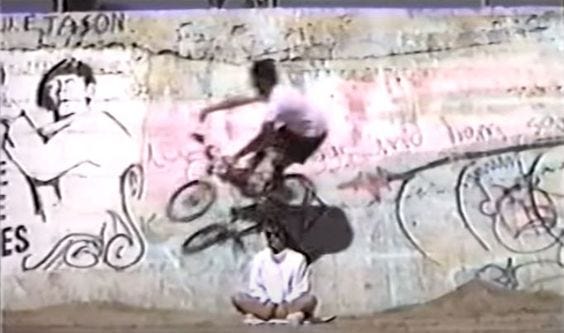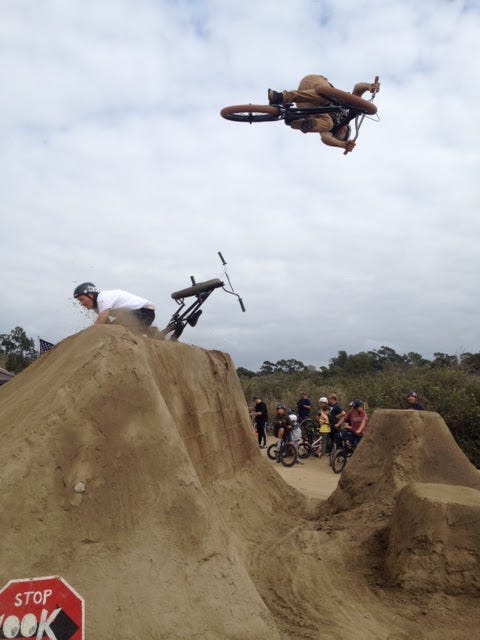The search for stoke
The rise of the age of STOKE, and the search for a lifestyle where the act of living itself is its own reward
This is me, searching for the stoke. This was one of my favorite places to ride in the late 1980’s and 1990’s, the Blue Brothers Wall in Huntington Beach. Wall ride over my sister Cheri’s head in 1990. The wall is under vert, maybe 80 to 85 degrees, so you can ride higher than on a fully vert wall, and really stick to it. This is a still shot from the intro of my 1990 self-produced BMX video, The Ultimate Weekend.
In the 2000’s, we started hearing things in the business media about the new young generation coming up, the Millennials. Born roughly from 1981 to 1996, and coming of age around the start of the new millennium, this was the first generation to grow up with personal computers, home videos and VCR’s as kids, pretty good video games, and that new fangled thing called the Internet. Business people began to complain that these Millennial kids, then turning into young adults, weren’t as materialistic as the previous generations. “These crazy kids want ‘experiences’, they’re not as focused on material success as previous generations,” business leaders complained. The marketers of 20-25 years ago couldn’t figure out where this crazy hunger for “memorable experiences” came from.
But it didn’t surprise me much, when I stopped to think about it, as an older member of Generation X. Millennial kids not only watched Disney movies like Oliver & Company and The Little Mermaid, 600 times each as kids, they grew up watching the first generation of low budget action sports videos over and over, as well. As one of the pioneers of rider-made BMX freestyle videos, that was one of the first times I realized how much of an impact all of our cheaply produced, crazy videos, had on the younger generations. BMXers, skateboarders, surfers, snowboarders, and free ride motocrossers were going out day after day, having little adventures. Those videos opened the younger kids up to getting a little crazy and having a different kind of fun then the jocks and cheerleaders in school.
Midget Cory Walters spins a flat 360, looking to avoid the carnage as Cody Brown bails in front of him. Sheep Hills, Costa Mesa, California. #steveemigphotos
Us Gen X kids had three channels of TV as little kids, so after school we were watching Speed Racer, Johnny Sokko and Giant Robot, The Brady Bunch, and Gilligan’s Island reruns, day after day after day. Most of us were in high school when VHS VCR’s really became popular. But the rise in action sports with Gen X, combined with the falling price of home video cameras and prosumer editing systems in the late 1980’s, led to us creating our own videos. So as the mass of Millennials grew up, they had Disney movies on video, 100 or more channels of cable TV, and our action sports videos, like Bones Brigade III: The Search for Animal Chin, Vision’s Barge at Will, Sims Snowshredders, Snowboarders in Exile, Eddie Roman’s Headfirst featuring a young Mat Hoffman, and in 1994, Crusty Demons of Dirt, any surf video with Christian Fletcher in it, along with dozens of other videos NOT produced by Hollywood professionals. Millennial kids were the first generation to have all these alternative forms of entertainment to watch as kids.
What did all these videos have in common? They all had weird, often fairly dysfunctional, yet highly creative, pretty crazy, action sports people going out, day after day, doing exciting stuff, and having crazy experiences. Even if the average Millennial kid didn’t own any of these videos, their older brothers or their friends had some copies, on VHS, so they could watch them dozens, maybe even hundreds of times, each. That influence, combined with recoil from the massive over indexing on material success in mainstream 80’s society, is part of what drew Millennials towards new, weird, crazy, and exciting experiences. It’s not the whole story by any means, but I think this is one factor that influenced lots of Millennial kids.
What were all those action sports athletes after? Why did they begin pushing the limits on things like surfboards, skateboards, BMX bikes, snowboards, and motorcycles? The were after the stoke. That feeling of landing a move or trick you weren’t sure you could do, or landing something difficult really well, and just stomping it. When the X-Games came along in 1995, and jumped on the action sport bandwagon, marketers and mainstream media dubbed these sports “extreme sports.” They called these crazy action sports people adrenaline junkies. It wasn’t the adrenaline all these riders and skaters were after, it was the dopamine, the natural high from pushing your personal limits, and doing some physical move you weren’t sure you could do at first. Beginning in surfing, I believe, this feeling was most often referred to as stoke.
This kid’s expression just sums it up. Stoke is the older kids, and adult version, of the giggling glee you see in babies, like this kid above. My meme from a vintage public domain photo. #steveemigmemes
Generation X, born from about 1965-1980, was the last generation born into the thriving Industrial Age. We are also the 13th generation of the United States, as a country, and the number 13 has an age old history with change and transition. In any case, us Generation X kids were born into a world where the majority of working people worked in large factories, or the offices attached to the factories. These factories were spread across the U.S., in small and medium sized towns, as well as large cities. The nature of most of these jobs was “shut up and do your job, you don’t have to like it, you just have to do it.” Corporate conformity in dress and attitude was the order of the day. Most adults I knew did not like their jobs when I was a kid. But the jobs paid well, put food on the table, and paid the rent or mortgage payment. The average man working in a factory or office could raise a family and buy house house on a single income then. We still had gold-backed currency when us older Gen X kids were born, until President Nixon took the dollar off the gold standard in 1971. So while there was inflation in the 1970’s, the financial system wasn’t anchored down with trillions of dollars of insurmountable debt, like it is today. That meant that a much larger percentage of the money supply was flowing around the real world, Main Street economy.
What difference does that make? Generation X grew up in a world where factories still reigned, people all bought the same massed produced clothes, and other goods, in huge, mall department stores. Back then, in the 1970’s, a phone was something on the kitchen wall that only made phone calls. Many of our parents and grandparents worked 40 years at the same job, in the same factory, their whole lives. We were born into a world that people under 35 or 40 can’t even imagine today. New technologies, combined with many different social movements, have changed every day life dramatically since then. The idea that you could actually do a job that was interesting, exciting, and be part of positive force in the world, didn’t really exist. Spending most of your waking hours at a job most you dreaded going to every day, was just the nature of things. If you questioned that basic idea of spending your life doing a job you hated, adults told us, “You just don’t understand the way the world works.”
I remember thinking as a kid, maybe 10 or 12 years old, “There has to be another way to live life.” Every adult seemed to hate their job, though many actually liked the kind of work they did. But they hated their bosses, or being repeatedly told, “We don’t want your ideas, just do your job.” Most adults I knew as a kid spent all weekend drinking a lot of beer and complaining about going to work on Monday. So growing up and getting a job didn’t look like much fun to us. But that Middle Class life of misery but a comfortable lifestyle, was just the way things were.
In addition, us Generation X kids had two big, outside the mainstream influences as little kids. the first was a Chinese American martial arts expert named Bruce Lee, in a small group of movies like no other movies we had seen. The second influence was a flamboyant daredevil,dressed in white leathers, with a cane and a cape, who jumped over cars on a motorcycle, Evel Knievel. Those two got a whole generation of boys, and a few girls, secretly dreaming of being a kung fu star or a stuntman. That was in a time where our parents wanted us to become doctors and lawyers, and make a lot of money, and have a secure future. But deep down they knew we’d wind up working on the line in one of the local factories.
Into that world came these weird new “fads,” like skateboarding, motocross riding, BMX bikes, and surfing, for those who lived in California. Suddenly us average kids across the U.S. could be stuntmen, sort of, on a skateboard or a BMX bike, or even snow or water skis. Many of us started these activities as just fads. Some kids got hooked on these weird things, and competitions evolved, turning these activities into new, weird, little sports. They weren’t “real” sports, like football, basketball, baseball, and hockey, but they were kind of sports, though not taken seriously for many years.
But these sports were different from the start. There was no coach blowing into a whistle and yelling at us, or making us do wind sprints in practice. In BMX, skateboarding, motocross, surfing, skiing, and other action sports, we didn’t have coaches. We could ride or skate as hard as we wanted, and sit down and take a break whenever we felt like it. The “practice,” was the fun part. We went to competitions, because as kids, we were taught that the whole point was to win at any cost. That’s all we knew about sports, to try to “win.”
But these were all subjectively judged sports, and the most innovative and interesting riders and skaters often didn’t win. But they did the runs we remembered a month later. Usually we couldn’t remember who won the contest a couple of days later. Competitions were important to get sponsors, and to get coverage in magazines, once people rose to that level. But as these sports evolved, and surged in popularity, contest wins lost much of their value, and style and innovation gained in importance. By the late 1980’s, most of us would rather be the kid who landed a new trick at the contest, than they guy who won it.
We were beginning to figure out progression was what was really important, the stoke of inventing some new move, and then pulling it at the next contest, in front of all the riders we respected. The stoke of actually going out and pushing ourselves day after day, and progressing on our own personal level, became what was really important. Those magic moments when we our riding or skating just flowed. That feeling or experience has many names. The Zen moment. The flow state. Being in the zone. The effortless experience. No mind. Letting it just happen. Musicians and artists have known about this for a couple of thousand years or more. Poets and writers and painters know about it. Zen archers in Japan have known about this for hundreds of years. Samurai Miyamoto Musashi knew about it ages ago. Takuan Soho wrote about the “no mind” state 400 years ago. Martial artists have known about it for generations. Runners have spoke of the “runner’s high” for decades. But it took action sports for thousands of Generation X kids to find out this amazing flow state exists, and to experience the stoke that goes with it. Once you’ve felt it, you want to experience it again… and again. The search for stoke begins.
That’s what us BMXers and skateboarders began to experience in the 1980’s. Around that time, in the late 1980’s and the early 1990’s, video cameras became affordable, and we started shooting videos of us riding. Within a few years, a good video part did more for a rider than a contest win. At the same time, other action sports were coming of age, like snowboarding, mountain biking, wakeboarding, and motocross free riding, which became freestyle motocross or FSMX.
In the long recession of the early 1990’s, riders and skaters and snowboarders began making our own videos. The still shot at the top is from a video I made in 1990, just one of dozens and dozens of athlete-made videos of the early 1990’s. These sports weren’t on TV yet, and we were all infused with the punk rock, Do It Yourself, or DIY, ethic. So we became our own media in that era, producing our videos and magazines. A whole new, younger generation, the kids who later became known as Millennials, watched these videos as young kids and teens. This drew a lot of new kids into all these sports, and all the new, emerging, action sports variations, like bodyboarding, skim boarding, kite surfing, and others. And what were we all searching for, day after day? Stoke. That state where it was effortless to do our hardest moves for a short period of time. We were seeking that natural high, the dopamine rush, that came from doing a physical activity really well, or doing a new trick or move for the first time.
Check out my Pinterest page, with collections of hundreds of action sports photos
As the oldest Millennials were getting into high school, and the youngest were just entering school, ESPN hopped on the action sports bandwagon, and created the Extreme Games, in 1995. They needed lots of content to get their second channel, ESPN 2, off the ground. The next year, they rebranded the event the X-Games, and it has been changing and evolving since. Those first few years were pretty weird. They had really obscure things like competitive bungy jumping, sky surfing, skateboard street luge, and some hoopty ideas like skateboard doubles. But the X-Games also showed the action sports world to an audience of millions on TV, including the young Millennials, and Gen Z kids in the early 21st century. The search for stoke found a much bigger audience.
It’s now 2023, and we now have three generations of people alive for whom action sports always existed. They don’t remember a time before these sports. There’s a whole new crowd of young skaters, surfers, and riders, continuing to search for their own stoke, and they push and evolve action sports in new directions. So while lifelong skaters like Chris Miller, Steve Alba, and BMXer Dennis McCoy ,still shred in their 50’s, younger people are evolving action sports in new directions. Colby Raha has taken freestyle motocross to the streets. Skaters like Nyjah Huston and Leticia Bufoni rock the competitive scene, and put down solid video parts. BMXer Perris Benegas shows women have huevos, just like guys, even earning high 5’s from Dennis Enarson on street. Japanese rider Ayato Kimura is pushing mountain biking to new levels as a young guy. And, of course, young Sky Brown is blowing minds, getting mainstream media coverage at the Olympics, and drawing a whole new generation of girls into skateboarding. The search for stoke and progression continues. Where do you find stoke?





